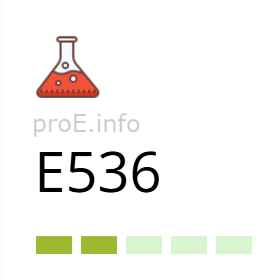
Other names for the additive (synonyms)
General Information
Food additive E536 is a complex compound of divalent iron, usually found in the form of a trihydrate. This additive is known under several names:
- yellow prussiate of potash,
- potassium ferrocyanide,
- yellow salt,
- prussiate of potash,
- potassium hexacyanoferrate,
- ferrocyanide of potassium.
The name "yellow prussiate of potash" originated because the substance was formerly obtained by fusing slaughterhouse blood with potash and iron filings. The resulting crystals had a yellow color.
Today, food additive E536 is produced industrially from waste mass containing cyanide compounds, left over from gas purification at gasworks.
Potassium hexacyanoferrate is the product of the reaction between hydroferrocyanic acid and potassium hydroxide. Its molecular formula is K4[Fe(CN)6]•3H2O.
This compound was first discovered by French chemist Pierre Macquer in 1752. He observed that when Berlin blue was boiled with an alkali solution, its blue color changed to a yellow substance.
Potassium ferrocyanide is not soluble in alcohol, but up to 300 grams of additive E536 can dissolve in one liter of water.
The additive is low in toxicity, but when it reacts with water, it may release poisonous gases. These gases are typically not present in quantities dangerous to health. However, when potassium hexacyanoferrate comes into contact with acids, it may release a highly toxic gas — hydrocyanic acid.
Key properties of food additive E536:
- Taste – bitter-salty.
- Color – yellow, amber.
- Odor – none.
- Texture – crystalline powder.
Effects on the Body
Risks of Additive E536
Currently, there are no data from biotests or studies on how food additive E536 behaves during different types of food processing (e.g., frying, boiling). Although it is generally used in small quantities and only in mixtures with table salt, violations of production technology and exceeding the permitted levels can pose a health risk.
The maximum permitted level of potassium ferrocyanide in table salt is up to 20 mg per 1 kg of product.
In the scientific opinion of the Panel on Food Additives and Nutrient Sources Added to Food on the re-evaluation of the safety of sodium ferrocyanide (E 535), potassium ferrocyanide (E 536), and the evaluation of calcium ferrocyanide (E 538) as food additives, additive E536 was deemed safe for human health when the acceptable daily intake does not exceed 0.03 mg/kg of body weight.
Main symptoms of potassium ferrocyanide overdose:
- laxative effect;
- intestinal pain;
- skin inflammation, acne;
- disruption of the gallbladder and liver;
- lymph node inflammation;
- body intoxication.
The additive does not break down into cyanide in the body. Inhalation may irritate the respiratory tract. When interacting with acids (including gastric acid), the substance breaks down, releasing hydrocyanic acid. This gas can also be released when the substance is heated to 50°C. However, no research has confirmed how potassium hexacyanoferrate behaves in food during heat treatment.
Benefits of Additive E536
The beneficial effects of potassium ferrocyanide are not confirmed. However, the compound is considered to have low toxicity.
Uses
In the food industry, additive E536 is mainly used as an anti-caking agent, especially in table salt (it helps lighten the color of the product).
It is used:
- in sausage production (potassium ferrocyanide is responsible for the white coating on sausage casings);
- in winemaking – additive E536 acts as an emulsifier that removes excess heavy metal cations from wine materials;
- in the production of ready-made seasoning mixes and spices;
- in cheese making – it helps maintain a crumbly texture;
- in baking rye and unleavened bread.
Other applications of potassium ferrocyanide:
- in non-food industries – for producing pigments, dyeing silk, coloring paper, as a component of anti-corrosion coatings, and in steel case hardening;
- in chemical industry – for manufacturing cyanide compounds and isolating radioactive carbon;
- in agriculture – as a fertilizer.
Legal Status
The use of food additive E536 is officially permitted in Ukraine, the European Union, and the United States. However, it is only allowed in strictly regulated quantities. E536 is also included in the Codex Alimentarius list of approved additives for use in salt and seasoning mixtures.